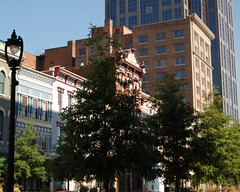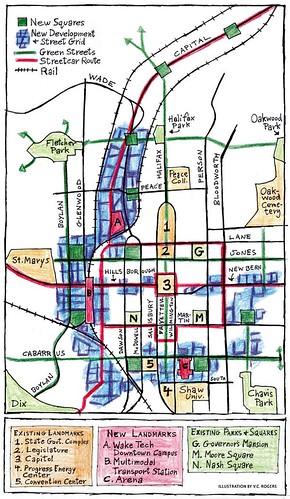Bold, smart, green vision proposed for Raleigh

Posted October 13, 2009 at 1:57PM
Dan Douglas was, until recently, chief downtown planner and director of the Urban Design Council in Raleigh, the state capital of North Carolina. He is now in private architectural practice, but his passion for the city remains, apparently. In particular, he is now proposing that a public/private corporation be formed to undertake a major overhaul of Raleigh's downtown.  According to a story written by Bob Geary for the online publication IndyWeek.com, Douglas is thinking big, bold, smart, and green.
According to a story written by Bob Geary for the online publication IndyWeek.com, Douglas is thinking big, bold, smart, and green.
Among the exciting possibilities:
- Nine new public squares, two of which would also function as green roofs for parking facilities.
- Buildings at a European-scale height of six to seven stories, except in the heart of downtown, where they might be taller.
- A major multi-modal transit center for buses, commuter rail and a hoped-for future high-speed Amtrak line.
- Six "green streets" where cyclists and walkers would be given priority.
- New cultural and civic facilities.
- Major increases in downtown residential units and jobs.
 On the map at right, the areas that would have new development are shown in blue, along with new streets in a tighter grid. The new squares and green streets are shown in green. And the route of a proposed new streetcar line is in red. Click on the map for more detail.
On the map at right, the areas that would have new development are shown in blue, along with new streets in a tighter grid. The new squares and green streets are shown in green. And the route of a proposed new streetcar line is in red. Click on the map for more detail.
The planner says that the new jobs and downtown homes could bring an additional $73 million in tax revenues to the city each year.
This would, of course, require major capital investment on an unprecedented scale. But it wouldn't be the first time something on a mega-scale was attempted in North Carolina. The brainchild of the 1950s and1960s was Research Triangle Park in nearby Durham County. RTP is now home to some 157 corporations and organizations (including an arm of the US Environmental Protection Agency) and 39,000 employees on 7000 acres. (With mandated low density, it is also now a sprawl and traffic nightmare, but it was a progressive idea for its day.)
Under Douglas's downtown vision, the new corporation would be modeled on the one that built RTP and would have among its major partners the city of Raleigh, the state of North Carolina, various utilities and railroads, and the region's transit agency:
"Combined, Douglas says, these partners own 120 acres of vacant or underutilized land in the prime railroad corridor that runs through the heart of the city and up Capital Boulevard to Atlantic Avenue. The partners would donate their land to the corporation, which Douglas calls Capital City Partners, giving it an enormous asset with which to leverage private and public development-commercial, residential and cultural-on a grand scale.
"The
corporation would then hold an international competition to produce the best possible master plan for downtown development. This could include new public squares, transit stations, high-tech businesses, high-density housing-a significant amount of it, affordable-arts and cultural hubs: All this, to create a bustling, vibrant, walkable and green downtown . . .
"Raleigh would go, as he foresees it, from languishing among the worst cities in the country in terms of wasted land and energy-a city built on sprawl-to being the greenest city in the Southeast and among the greenest in the world. It would be transit-oriented, not just car-dependent. It would be the kind of creative city that drives and thrives in the world economy."
Like I said, the man is thinking big. Douglas is also, according to Geary's article, drawing inspiration from several European cities he visited while on a recent Eisenhower Fellowship, including Bilbao, Barcelona, Freiburg, and Madrid. He saw brownfield redevelopment, public squares, solar panels, transit-oriented development, living downtowns, and affordable housing, parks and cultural facilities, and economic development strategies that made them happen. And he thought, why not Raleigh?
I'm not ready to bet my house on all of this happening, but I love it that someone is pushing the envelope, and I love it that this kind of thinking has come to Raleigh. Other cities, take note. Go here for the full story.